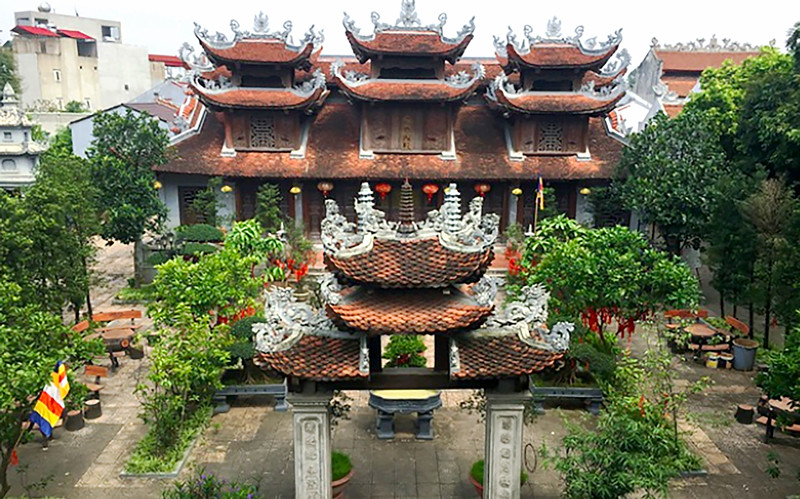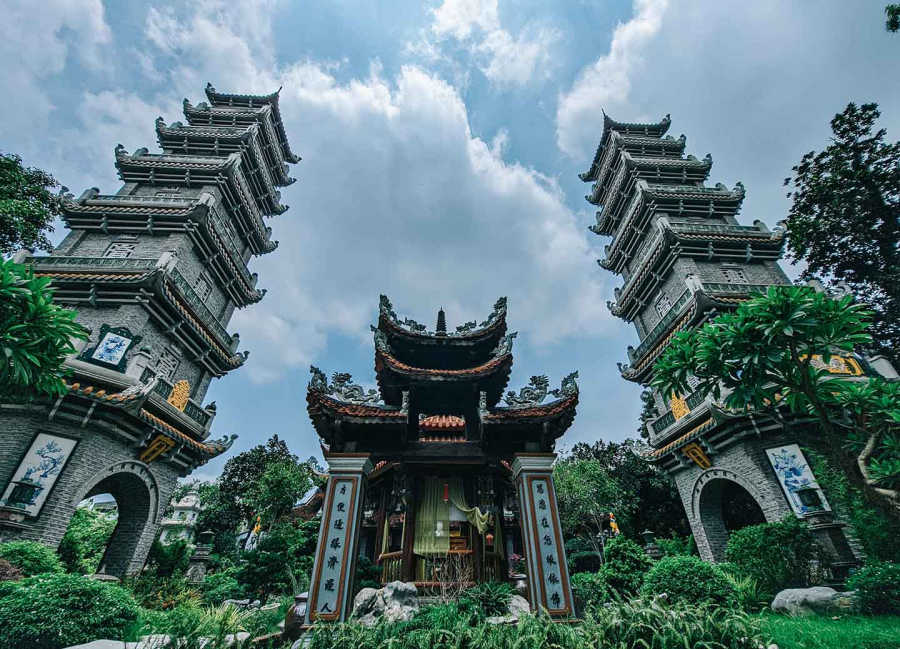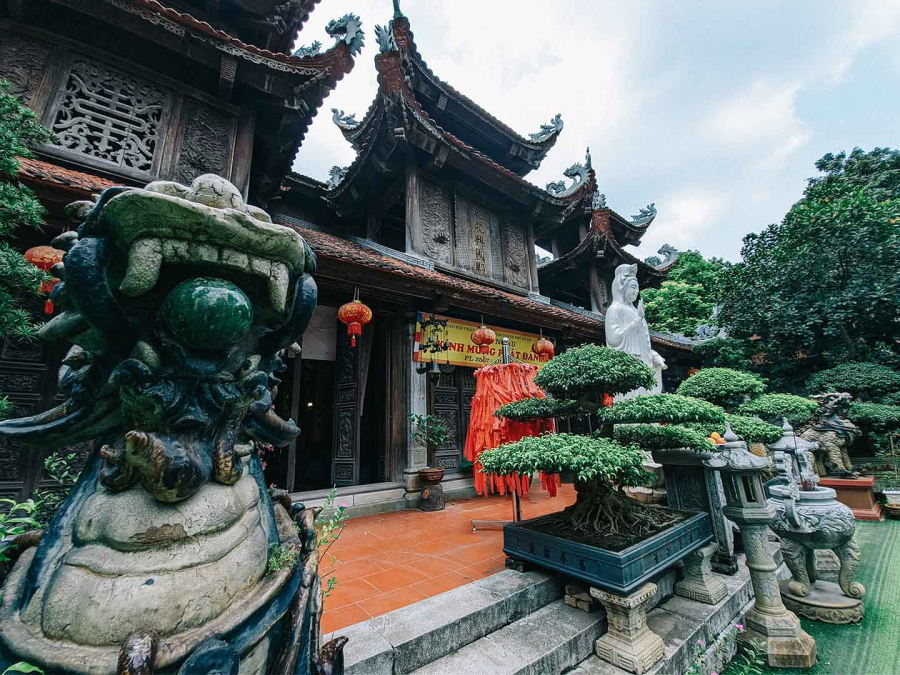In the heart of Hanoi, the city of a hundred years of civilization, alongside the busy and modern life, there still stand ancient and majestic pagodas, which hold countless legends and ancient memories. Some pagodas have preserved their ancient beauty, mossy walls, and the solemnity of time, especially the Ngau Pagoda – a symbol of survival and tranquility amidst the bustling life.
Nestled in Ngau Village, Yen Nguu Hamlet, Tam Hiep Commune, Thanh Tri District, Ngau Pagoda has long been an essential spiritual part of the local residents. Over nearly a millennium of historical storms, Ngau Pagoda stands strong as a lively witness to the firm will and strong faith of the people. Despite the time that may blur the delicate lines, the sacred space remains alive, as if silently retelling the glorious tales of a bygone golden era.
Ngau Pagoda not only serves as a spiritual haven for the locals to pray for a peaceful life, abundant health, and a serene soul, but it also attracts numerous visitors from all over who come to visit. They come here not only to admire the beauty of the historical walls cherished by time but also to immerse themselves in the peaceful atmosphere amidst the vibrant capital city. The serene scenery with lush trees and the pure sound of bells at dawn or sunset has quietly become an endless source of inspiration for anyone seeking a moment of tranquility in the busy life.

The serene scenery of Ngau Pagoda with its lush green trees
Furthermore, Ngau Pagoda preserves outstanding cultural and architectural values through its intricate sculptures, statues, and stone inscriptions that bear the mark of time. Every traveler’s step through each alley, every meticulous gaze can feel the exquisite blend of art and spiritual faith, rich culture, and the mark of history. A beautiful architectural ensemble, a diverse cultural space, has been carefully preserved and maintained for hundreds of years, becoming a point of pride for the people of Hanoi.
Ngau Pagoda is more than just an ordinary spiritual site; it is a gathering place of belief, where people come to make wishes and pray. Whether locals or distant visitors, everyone who sets foot here brings their own personal experiences, their own special stories. All of these experiences seem to be encapsulated in the peaceful and solemn space of the pagoda. This pagoda not only serves as a refuge for souls seeking peace but also as a connection between the past and the present, between traditional culture and innovation, between spiritual life and the diverse cultural life of the capital’s people.
The Chua Ngau Pagoda is also known as Hung Long Tu Pagoda or Quoc Lao Hung Long Tu Pagoda. According to historical stories, the ancient Yen Nguu Village had the Muc Dong Temple worshiping the village deity Yen Nguu and the Dieu Linh Temple worshiping Huong Tu Thanh Van, a revered female deity (also known as Ancestor Ngau). The pagoda is believed to have been founded by Queen Le Thei Hoang in 1130 (during the reign of King Ly Than Tong) at the location of the Dieu Linh Temple to honor Buddhism along with the worship of Ancestor Ngau.

The name of Ngau Pagoda is Hung Long Tu
Ngau Pagoda once sank into oblivion and serious degradation until, in 1762, a senior scholar of the Le dynasty initiated a restoration campaign. To acknowledge this act of kindness, the villagers decided to honor him by naming the pagoda Quoc Lao Hung Long Tu. According to the inscription on the “Quoc Lao Hung Long Tu Bi Ky” stele erected in 1763, it mentioned that the poet Nguyen Du frequently visited Yen Nguu. After achieving success, he requested a piece of land to construct a Thai Ap and presided over the call for local residents to jointly restore Ngau Pagoda. The construction of the pagoda was completed in 1763, the same year he passed away, and since then, the people have honored him by worshiping him in the very pagoda he helped restore.
During the difficult period of struggle for liberation, Ngau Pagoda, located on the banks of the To Lich River and near National Highway 1A – a vital route, became a storehouse for military equipment and ammunition, while also serving as a safe haven for revolutionaries. Due to its strategic role, the pagoda did not escape attacks and was subsequently forgotten for a long time. However, in 1995, the pagoda underwent a major renovation and was recognized as a national historical relic, receiving deserving attention and preservation.

Ngau Pagoda recognized as a national historical relic in 1995
Despite undergoing numerous renovations, Ngau Pagoda still preserves its ancient and peaceful beauty. Architectural elements such as the Tam Bao sanctuary, Ancestral Worship Hall, Hưng Quốc Emperor’s Court, and the Three Gateways retain the solemnity of the past. The pagoda also houses many valuable artifacts, especially a bronze bell cast in the 7th year of the Canh Thinh dynasty (1799), measuring 1.24m in height and 0.6m in diameter, with a bell handle intricately carved with two dragons with curling tails, bearing the inscription “Hung Long Tu Chung” on its body. Surrounding the pagoda, glimpses of the past can be seen through the lush fruit-laden trees such as jackfruit, mango, and longan.
Ngau Pagoda has become a sacred place, attracting many people seeking peace and enlightenment, disconnected from their busy and hurried lives. In every corner, every architectural detail, and the serene atmosphere of the pagoda, the old images are well preserved, not emphasizing fancy appearances and colors, but leaving an indelible mark in the hearts of visitors when they visit and pay respect.






































